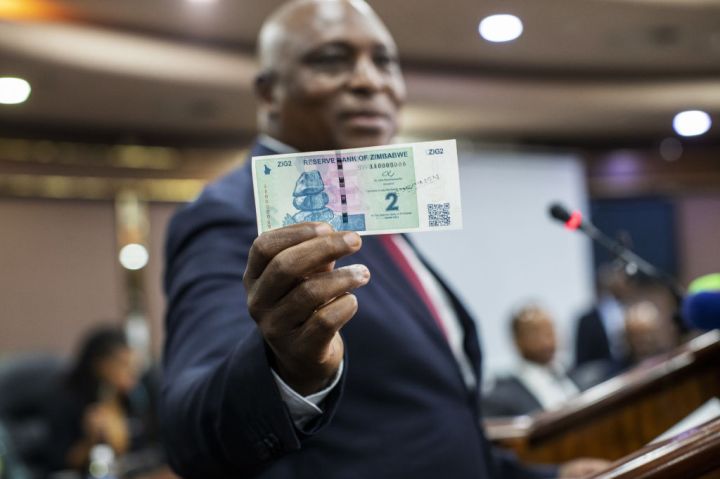
This is Zimbabwe’s sixth attempt to create a functional local currency since 2008, when inflation crossed 500 billion percent, making it worthless. Why does the Zimbabwean government keep trying to do this? I suspect the answer is simply cronyism gone completely into hyperdrive.

On May 29 2024, South Africans will make their mark in another way.
Get your exclusive, in-depth Election 2024 newsletter curated by Ferial Haffajee delivered straight to your inbox.
Zimbabwe’s new central bank governor, John Mushayavanhu, has come up with a new way of trying to establish a functional local currency: a currency backed by Zimbabwean gold reserves. Why is this happening, what does it mean, and will it succeed?
The reason it’s happening is simple: the re-establishment of the Zimbabwean dollar in 2019 has inevitably been a disaster. The Zim dollar has lost 87% of its value this year, which is less of a disaster than it might seem because only 5% of financial transactions in Zim happen in Zim dollars. But more seriously, hyperinflation is back and is running at 52%. So, to try to protect the currency, interest rates have once again been hiked to absurd levels.
To avoid yet another economic crisis, the new idea is to return to the gold standard. The government has issued the ZiG, which stands for Zimbabwe Gold, which is backed by 2.5 tonnes of gold in the vaults of the Reserve Bank of Zimbabwe. Essentially, the idea is to inject confidence into the currency by making it theoretically transferable into gold, which has a market-established, internationally accepted exchange rate.
Problems
But there are problems with doing so. The first is that 2.5 tonnes of gold isn’t that much; it’s currently worth just under $300-million. Compare that to the theoretical size of the Zimbabwean economy of $27.37-billion and it quickly becomes apparent that not every ZiG will be entirely covered by actual gold. Mozambique — a country with a smaller GDP than Zimbabwe — has gold reserves almost twice as large.
So there is an element of “watch these hands” about the move, and reports on the ground suggest ordinary Zimbabweans are not fooled; the take-up of the new currency is very small. However, rich Zimbabweans love the idea since it means they can now turn their Zim dollars into something more or less internationally transferable.
Of course, the Zim government knows that its financial plans are going to be treated with suspicion, so, when there is no trust, you have to pull out the big stick: 50% of taxes will have to be paid in ZiG. This is effectively a measure to enforce transfer, but this is too little, much, much, much too late.
The Zimbabwean economy has long ago “informalised”; it is just not possible to conduct ordinary business in that country, so to protect themselves, citizens are practising what you might call survival business on an informal level where they can duck under scrutiny and regulation.
Cronyism
This is Zimbabwe’s sixth attempt to create a functional local currency since 2008, when inflation crossed 500 billion percent, making it worthless. Why does the Zimbabwean government keep trying to do this? I suspect the answer is simply cronyism gone completely into hyperdrive.
It works this way: as the economy collapses, the only way to get it going again is to jettison the currency. But, over time, the consequence is that the government can’t maintain its popular support by offering blandishments to government employees, for example.
Hence, the currency is re-established, and the Reserve Bank of Zimbabwe is encouraged to over-print the new currency. Once that happens, however, the kleptocrats who now make up almost the entire Zanu-PF leadership find it difficult to convert their local currency holdings into something that means anything. So the government either turns a blind eye to the circulation of a foreign currency, or formally legitimises it. But without the ability to turn on the currency printing presses, political support starts to look dodgy — and so the cycle begins again.
The president and the governor
The clue to understanding why this cycle continues is to examine the relationship between Zimbabwe’s president and the governor of the Reserve Bank of Zimbabwe. Bear in mind that the general idea is that they should be independent of each other. However, in this case, President Emmerson Mnangagwa and Mushayavanhu are longstanding business partners.
Their business relationship goes back to the Congo War of 1998-2000, in which Mnangagwa and Mushayavanhu worked together in Zanu-PF’s business in the DRC. And that wasn’t the end of it, of course. When Mnangagwa was Zanu-PF’s secretary for administration, just one of the prominent deals they did together was the $29.3-million acquisition of the energy company Zuva Petroleum. Mushayavanhu’s company was called Wobble Investments. I am not making this up.
It’s worth noting that the previous governor, John Mangudya, whose term expired, has not been cast out. Instead, he has been reassigned to the controversial Mutapa Investment Fund, formerly known as the Sovereign Wealth Fund, which now holds interests in almost all of Zim’s parastatals. That is how tightly this ship is run.
Economics from Mars
Will this work? Of course not. As my colleague Ed Stoddard pointed out this week, the IMF has just finished an Article IV mission to Zimbabwe. Its suggestion, if you want to put it in a plain-language nutshell, is that Zim should adopt the generally accepted economic rules of the planet Earth.
The Zimbabwean finance ministry must have asked for a bailout and this was the response: “An IMF financial arrangement would require a clear path to comprehensive restructuring of Zimbabwe’s external debt, including the clearance of arrears and a reform plan that is consistent with durably restoring macroeconomic stability; enhancing inclusive growth; lowering poverty; and strengthening economic governance.”
As I said, let’s try to focus on solutions from this century which are not derived from the Book of Martian Economics.
The core problem is this: Zimbabweans have no confidence in the economy, and establishing that confidence requires a new government. But Zanu-PF has not and will not allow that to happen because the precarious wealth of the tiny Zimbabwean elite would instantly implode.
What is happening in Zimbabwe is worrying and it’s causing citizens unnecessary pain. But what is interesting is how little the SA government seems to care, and how many of SA’s political parties seem to find no problem with Zimbabwe’s Martian economic system. DM



Does this government not realise that doing the same thing over and over again ( 6 times!) and expecting a different result is insanity?
No not at all this is called business to these guys. Listen up: This is how it works.
So the “new” currency has gold backing it, well just a little bit. Let’s say 1% for arguments sake.
The supply of this currency permeates the system and people use it to pay for goods and services. Some people save or buy pension fund assets and cars and houses. Some of this stock is just money that sits in handbags and car cubby holes.
Foreign goods are bought with USD and there is a rate at which the ZiG will buy USD. But the rate on the official market is always held way too low. Let’s say 15/1$.
The elite Zanu PF thieves have preferential access to the short supply of USD at 15. Forex is rationed so business and individuals must pay on the black market which is the only place they can get them pay 30.
So these political thieves borrow ZiG, and buy either USD or real assets…as much as they can. (Or the really connected buy the USD for 15 and sell them on the black market at 30, and again.) They then just wait for the G of The Central Bank to print them into riches..and then when the scheme is collapsing they can the “old” currency and issue a new one.
And so we have the Zim way of the elite making the paper worth more than the monetary value. Mugabe knew this and publicly declared that he could do this when he needs. That London School of Economics degree did him proud. And all the money sitting in handbags and cubby holes and saved in bank accounts or in the couch become zero.